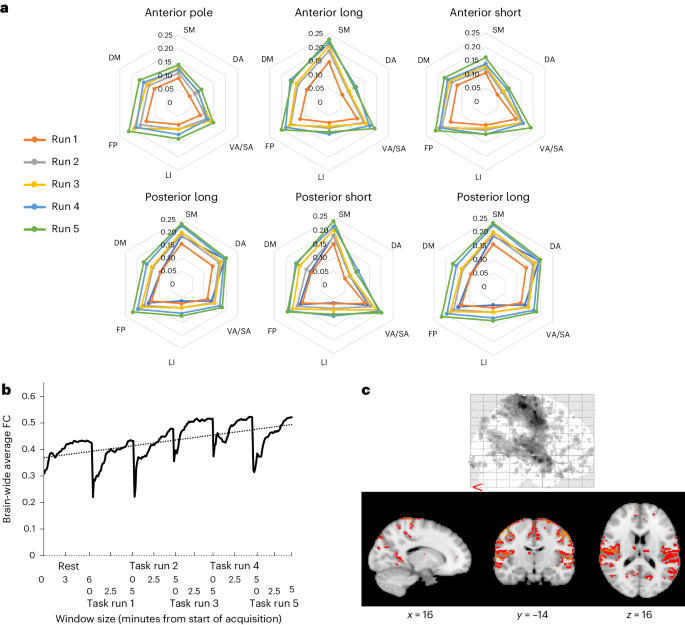
- Select a language for the TTS:
- UK English Female
- UK English Male
- US English Female
- US English Male
- Australian Female
- Australian Male
- Language selected: (auto detect) - EN
Play all audios:
Functional magnetic resonance imaging (fMRI) is a central tool for investigating human brain function, organization and disease. Here, we show that fMRI-based estimates of functional brain
connectivity artifactually inflate at spatially heterogeneous rates during resting-state and task-based scans. This produces false positive connection strength changes and spatial distortion
of brain connectivity maps. We demonstrate that this artefact is driven by temporal inflation of the non-neuronal, systemic low-frequency oscillation (sLFO) blood flow signal during fMRI
scanning and is not addressed by standard denoising procedures. We provide evidence that sLFO inflation reflects perturbations in cerebral blood flow by respiration and heart rate changes
that accompany diminishing arousal during scanning, although the mechanisms of this pathway are uncertain. Finally, we show that adding a specialized sLFO denoising procedure to fMRI
processing pipelines mitigates the artifactual inflation of functional connectivity, enhancing the validity and within-scan reliability of fMRI findings.
The HCP dataset is publicly available on the open access Connectome database (https://db.humanconnectome.org/app/template/Login.vm), which can be accessed after signing a data use agreement.
The PSU (https://openneuro.org/datasets/ds003768/versions/1.0.9) and YMRRC (https://openneuro.org/datasets/ds003673/versions/2.0.1) datasets are publicly available on the OpenNeuro
repository. The MIC dataset is available upon reasonable request to the corresponding author.
The code for assessing the presence of brain-wide FC inflation in an fMRI dataset is publicly available at
https://github.com/ckorponay/Connectivity-Inflation/blob/main/FC_Inflation_Evaluator.m. The code and instructions for performing RIPTiDe denoising using the rapidtide package are publicly
available at https://rapidtide.readthedocs.io/en/latest/usage_rapidtide.html#removing-low-frequency-physiological-noise-from-fmri-data.
This work was supported by grant no. 5R01DA039135-06 to A.C.J., the Intramural Research Program of the National Institutes of Health, the National Institute on Drug Abuse (to A.C.J.), and
grant nos 1RF1MH130637-01 and 1R21AG070383-01 to B.B.F. The funders had no role in study design, data collection and analysis, decision to publish or preparation of the manuscript.
These authors jointly supervised this work: Amy C. Janes, Blaise B. Frederick.
Department of Psychiatry, Harvard University Medical School, Boston, MA, USA
Neuroimaging Research Branch, National Institute on Drug Abuse, Intramural Research Program, National Institutes of Health, Bethesda, MD, USA
C.K., A.C.J. and B.B.F. were responsible for study conceptualization, data collection, curation and analysis, and for writing, reviewing and editing the manuscript.
Nature Human Behaviour thanks Deborah Small, Wesley Vieira da Silva and the other anonymous reviewer(s) for their contribution to the peer review of this work. Peer reviewer reports are
available.
Publisher’s note Springer Nature remains neutral with regard to jurisdictional claims in published maps and institutional affiliations.
Springer Nature or its licensor (e.g. a society or other partner) holds exclusive rights to this article under a publishing agreement with the author(s) or other rightsholder(s); author
self-archiving of the accepted manuscript version of this article is solely governed by the terms of such publishing agreement and applicable law.
Anyone you share the following link with will be able to read this content:






